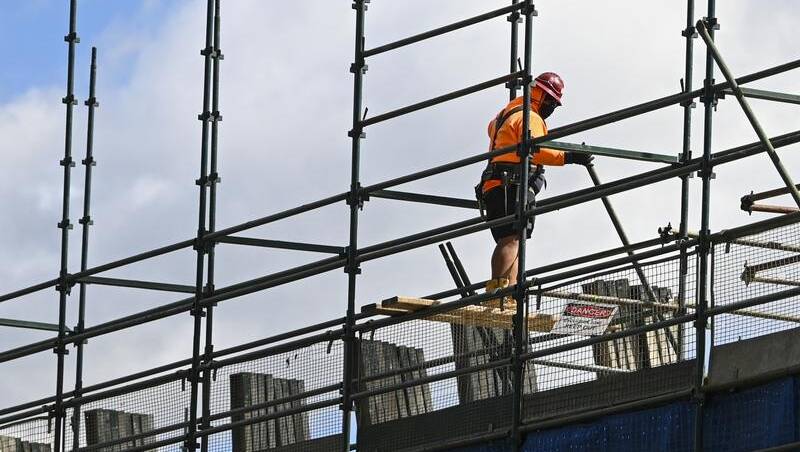
A modest decline in construction work completed across Australia in the September quarter suggests the widely anticipated economic contraction caused by COVID-19 lockdowns may not be as bad as first thought. However, NSW and the ACT did see big hits to their construction industries. The Australian Bureau of Statistics said construction eased just 0.3 per cent in the quarter to $53.9 billion nationally compared with three months earlier, when economists had predicted a three per cent drop. It still left annual construction growth 3.5 per cent higher compared to a year ago, the strongest pace in 3.5 years. ANZ senior economist Catherine Birch said the September quarter dip in economic growth could prove to be smaller than her earlier estimate of a 3.3 per cent decline. Even so, NSW and the ACT did suffer a major blow to construction from the COVID-19 restrictions, declining 8.1 per cent and 15.5 per cent respectively. The big surprise was that in Victoria, which was also in lockdown, construction actually rose 5.8 per cent. “Both NSW and the ACT experienced a construction shutdown, which was then followed by an extended period of workforce restrictions,” BIS Oxford Economics principal economist Nicholas Fearnley said. “The construction shutdown in Victoria occurred at the end of September and carried over into early October, so the December quarter is likely to show most of the impact.” The ABS said total building construction fell 0.9 per cent to $30.4 billion in the quarter. Residential construction was unchanged at $18.8 billion in the September quarter, while non-residential construction fell 2.2 per cent to $11.7 billion. In contrast, engineering construction rose 0.4 per cent to $23.5 billion. The data feeds into the September quarter national accounts due on December 1. Earlier figures showed retail spending fell 4.4 per cent in the September quarter, the largest quarterly decline on record. Before Thursday’s data, some economists believed the September quarter economic contraction could be as much as four per cent. If correct, it would represent the second-largest contraction in growth in the history of the national accounts – the record being seven per cent in the June quarter of last year and during the nation’s first recession in nearly 30 years. Economists will hone their growth forecasts after Thursday’s business investment figures, while data for company profits, business inventories, international trade and government spending will be issued early next week. Australian Associated Press
A modest decline in construction work completed across Australia in the September quarter suggests the widely anticipated economic contraction caused by COVID-19 lockdowns may not be as bad as first thought.
However, NSW and the ACT did see big hits to their construction industries.
The Australian Bureau of Statistics said construction eased just 0.3 per cent in the quarter to $53.9 billion nationally compared with three months earlier, when economists had predicted a three per cent drop.
It still left annual construction growth 3.5 per cent higher compared to a year ago, the strongest pace in 3.5 years.
ANZ senior economist Catherine Birch said the September quarter dip in economic growth could prove to be smaller than her earlier estimate of a 3.3 per cent decline.
Even so, NSW and the ACT did suffer a major blow to construction from the COVID-19 restrictions, declining 8.1 per cent and 15.5 per cent respectively.
The big surprise was that in Victoria, which was also in lockdown, construction actually rose 5.8 per cent.
“Both NSW and the ACT experienced a construction shutdown, which was then followed by an extended period of workforce restrictions,” BIS Oxford Economics principal economist Nicholas Fearnley said.
“The construction shutdown in Victoria occurred at the end of September and carried over into early October, so the December quarter is likely to show most of the impact.”
The ABS said total building construction fell 0.9 per cent to $30.4 billion in the quarter.
Residential construction was unchanged at $18.8 billion in the September quarter, while non-residential construction fell 2.2 per cent to $11.7 billion.
In contrast, engineering construction rose 0.4 per cent to $23.5 billion.
The data feeds into the September quarter national accounts due on December 1.
Earlier figures showed retail spending fell 4.4 per cent in the September quarter, the largest quarterly decline on record.
Before Thursday’s data, some economists believed the September quarter economic contraction could be as much as four per cent.
If correct, it would represent the second-largest contraction in growth in the history of the national accounts – the record being seven per cent in the June quarter of last year and during the nation’s first recession in nearly 30 years.
Economists will hone their growth forecasts after Thursday’s business investment figures, while data for company profits, business inventories, international trade and government spending will be issued early next week.
Australian Associated Press
Source









